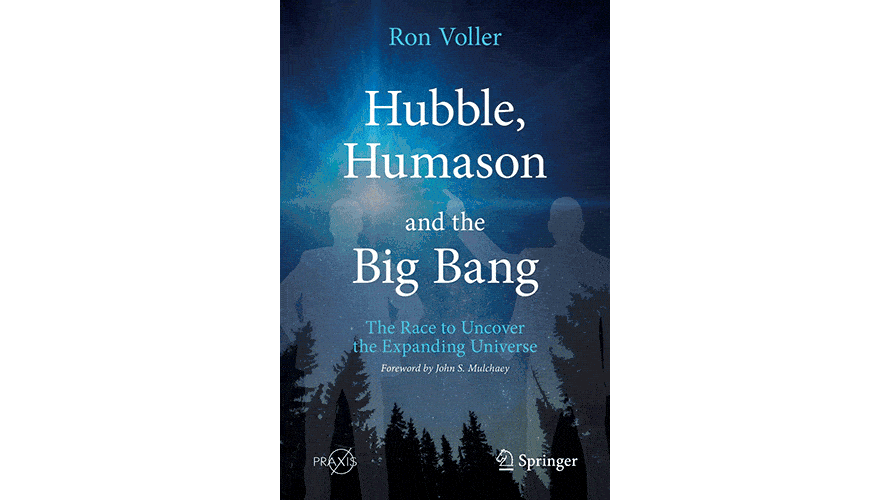Category: Nonfiction
Reviewed by: Casey Suire
Title: Hubble, Humason and the Big Bang: The Race to Uncover the Expanding Universe
Author: Ron Voller
NSS Amazon link for this book
Format: Paperback/Kindle
Pages: 462
Publisher: Springer
Date: October 2021
Retail price: $34.99/$25.47
ISBN: 978-3030821807
Edwin Hubble and Milton Humason. One is the namesake of a legendary space telescope. The other is virtually unknown outside the astronomy world. Combined, this unlikely duo changed humanity’s understanding of how the universe began.
Ron Voller’s enlightening book, Hubble, Humason and the Big Bang, will take readers back in time to California’s Mount Wilson Observatory. It’s the early 20th century, and Hubble and Humason are doing pioneering work that will ultimately lead to the Big Bang theory. Voller tells the story of how these two men got to this point in their careers. Interestingly, the pathway to Mount Wilson for both Hubble and Humason couldn’t have been more different.
The book, while emphasizing the pair’s work on discovering an expanding universe, is, in some respects, two biographies in one. Despite early dreams of becoming an astronomer, young Edwin Hubble studied law in order to please his devoutly religious father. Following his father’s death, Hubble returned to his original ambitions. In 1917, he received his Ph.D. from the University of Chicago.
In contrast, Milton Humason dropped out of school at age 14. Initially, he is employed as a muleskinner. While the observatory is being built, Humason hauls supplies up the mountain using mule wagons. Later on, he finds employment as a janitor and night assistant at Mount Wilson. Even though he suffers from “impostor syndrome” due to his lack of education, Humason begins moving up the ladder at the observatory. He soon became very skilled with Mount Wilson’s 100-inch Hooker telescope. He also excels at measuring the spectrum of very faint stars. Meanwhile, Edwin Hubble is researching nebulae, large interstellar clouds of gas and dust.
Hubble and Humason eventually joined forces and produced evidence that the universe is expanding. Their work gets the attention of the scientific community, prompting Albert Einstein to visit Mount Wilson Observatory in 1931. The two astronomers would continue to have a solid working relationship, even though their personalities were totally different. Unlike the quiet and modest Milton Humason, Edwin Hubble became somewhat of a celebrity in the media. Hubble also had a reputation for being difficult to work with. He frequently clashed with several members of the Mount Wilson staff.
The first chapter is about the accomplishments of numerous scientists who lived two centuries before Hubble and Humason. Examples include Galileo Galilei, Christiaan Huygens, Sir Isaac Newton, Albert Einstein, and Max Planck. For older readers, this opening chapter will feel like being back in physics class. For young students, it is a good introduction to many great minds. While the chapter is very long and covers a lot of information, it does discuss individuals that laid the groundwork for the discoveries of Hubble and Humason.
The “who’s who in science” theme continues for the rest of the book, as Hubble and Humason work with many noted astronomers. A few include George Ellery Hale, Walter Adams, Georges Lemaître, Walter Baade, and Allan Sandage. Voller also goes into great detail describing the construction and operation of several telescopes. Prominent examples include Mount Wilson’s 60-inch reflector and 100-inch Hooker telescope, along with the 200-inch Hale telescope at Palomar Observatory.
A chapter titled “A Portrait” is noteworthy for containing a fictionalized account of an early meeting between Hubble and Humason. Meant to give the reader insight into the mindset of each man, this approach is unique for a non-fiction book. Also, at various points in the book, the story of Hubble and Humason is interrupted for a few pages with a description of world events and pop culture from that particular period in time. These breaks in the book often have consequences for Hubble and Humason. For example, World War II impacts work at Mount Wilson as Edwin Hubble joins the American war effort.
Today, it is very obvious which astronomer is best remembered. In 1990, NASA launched the Hubble Space Telescope, arguably the most important scientific instrument in history. In comparison, most people are not familiar with Humason. While there are the Humason-Zwicky stars and the Humason crater on the Moon, Milton Humason isn’t exactly a household name. Voller deserves a lot of credit for bringing attention to his legacy. It’s worth noting that another book he wrote, The Muleskinner and the Stars, is the only complete biography ever written about Humason. Reading about Humason’s transformation from muleskinner to astronomer is perhaps the most intriguing aspect of Voller’s current book.
In conclusion, Hubble, Humason and the Big Bang is an interesting read for both astronomy buffs and those wanting to learn about the history behind the Big Bang theory. A very informative book worth reading.
© 2022 Casey Suire
Please use the NSS Amazon Link for all your book and other purchases. It helps NSS and does not cost you a cent! Bookmark this link for ALL your Amazon shopping!




















1 thought on “Book Review: Hubble, Humason and the Big Bang”
Hubble first gave idea of expanding universe in visual form by his law.